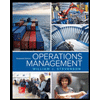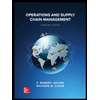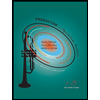
Practical Management Science
6th Edition
ISBN: 9781337406659
Author: WINSTON, Wayne L.
Publisher: Cengage,
expand_more
expand_more
format_list_bulleted
Concept explainers
Question
H4.
A manufacturing process consists of three processes. Step 1 requires 4 minutes per unit, step 2 requires 6 minutes per unit, and step 3 requires 7 minutes per unit. 20% of units that complete the third step require rework, which means those units must start the process over at step 2 (processing times are the same for units being reworked) and rework is always successful. Demand at the shop is 0.4 units per minute.
What is the capacity of the shop (in units per minute)?
Expert Solution
This question has been solved!
Explore an expertly crafted, step-by-step solution for a thorough understanding of key concepts.
Step by stepSolved in 3 steps with 5 images

Knowledge Booster
Learn more about
Need a deep-dive on the concept behind this application? Look no further. Learn more about this topic, operations-management and related others by exploring similar questions and additional content below.Similar questions
- A startup company is considering making a part by injection molding. The part is moderately complex and the volume of the part is about 10 cubic centimeters. Assume that the part is designed for injection molding and can be made with a two part mold. The company needs to make 250,000 parts made from ABS plastic. Once the mold is made it will take a worker 1 minute to make one part using the injection molding machine. The company will use contract manufacturing to produce the parts. Estimate the cost per part and explain how you came up with the number. (If you are stuck look at the Contract Manufacturing Cost per Unit section. Also keep in mind that there is no exact right answer, the goal is to come up with a reasonable estimate.) Contract Manufacturing Cost per Unit: It’s not uncommon to hire another company to perform some or all the manufacturing for a product. To estimate the cost use ((Cost of Parts and Materials) + (man hours) × $40)/.75arrow_forwardEquivalent units measure the amount of work done during a period, expressed in terms of fully completed units of output. True Falsearrow_forwardA machine makes two components; call them types A and B. It takes 250 seconds to switch production between the component types. During that time, no production occurs. When in production, each unit of A or B requires 0.5 second to be completed. The two components, A and B, are combined in an assembly process to make a final product; call it C. The assembly step can combine the two components into 1 unit every 2 seconds, or 30 units per minute. Assume there is ample demand. If the production schedule could be adjusted with the goal of minimizing inventory in the process, how many units of A should be produced before switching to component B? In other words, calculate the optimal batch size for component A. Assume the same number of units of B would be produced as well. answer:_______unitsarrow_forward
- An average of 1200 parts arrive to the EP chamber during an 8-hour workday. Each part goes through two stages of processing. At each stage, a single product is processed at a time, and processing takes an average of 15 seconds at the first station and 12 seconds at the second station. Inter-arrival times and service times are exponentially distributed. At the end of the second step, the product goes through a quality check. 5% of the parts fail the quality check and are sent back to the second stage of service. Parts exit the system only after they pass the quality check. Ignoring the time required to perform the quality check or in moving the part through the facility, what is the average cycle time for parts?arrow_forwardA cell-phone repair shop consists of three processes. Step 1 requires 4 minutes per unit, step 2 requires 6 minutes per unit and step 3 requires 2 minutes per unit. 40% of units that complete the third step require rework, which means those units must start the process over at step 2 (processing times are the same for units being reworked) and rework is always successful. Demand at the shop is 0.8 units per minute. Instruction: Round your answer to three decimal places. What is the capacity of the shop (in units per units per minute)? units per minutearrow_forwardThe bottleneck resource in a process has the least idle time. True or false?a. Trueb. Falsearrow_forward
- The information turnaround time is driven primarily by:a. the number of workers.b. the IT system.c. the inventory in the process.d. the amount of waste in the process.arrow_forwardA process of making chair is described as follows: Stage 1 Seat and back attached Stage 2 Legs attached The production speeds are 15 chairs per hour for Stage 1 and 30 chairs per hour for stage 2. The cycle time of the process is ______minutes. The flow time of the process is ______ minutes.arrow_forwardPlease do not give solution in image format thanku The flow rate through a process is 0.5 flow units per minute. The number waiting for the process is 1. The time to do the activity in the process is 1 minute. This is a stable system. The average amount of time a flow unit spends waiting for the activity and doing the activity = ______. Enter one integer (which can be 0) and ONE decimal, so the answer looks like X.X. Any of the Xs can be a 0.arrow_forward
- A machine makes two components; call them types A and B. It takes 630 seconds to switch production between the component types. During that time, no production occurs. When in production, each unit of A or B requires 0.5 second to be completed. The two components, A and B, are combined in an assembly process to make a final product; call it C. The assembly step can combine the two components into 1 unit every 4 seconds, or 15 units per minute. Suppose the machine rotates between one batch of 2,520 units of A and 2,520 units of B. In that case, what is the capacity of the machine in component pairs per minute, where a component pair is one unit of A and one unit of B? Suppose the machine rotates between one batch of 2,520 units of A and 2,520 units of B. What is the utilization of the machine? Suppose the machine rotates between one batch of 2,520 units of A and 2,520 units of B. What is the average inventory of B components? If the production schedule could be adjusted with…arrow_forwardChairs are made in a process with a single resource. There are two types of chairs. The resource's processing time for the first type is 30 minutes and demand for this type is 2.3 chairs per hour. The resource's processing time for the second type is 23 minutes and demand for this type is 2.8 chairs per hour. There is 1 worker at this resource. Instruction: Round your answer to one decimal place. What is the implied utilization (%) of this resource?arrow_forwardUse the following information to answer question 8-10. A company keeps track of the time required to fill orders carefully. The following data are presented: Hours Move time 2.6 Queue time Inspection time Delivery cycle time 0.4 15 Manufacturing cycle efficiency of the company is 0.12. The process time should be: A. 1.5 hours. B. 2.5 hours. C. 1.2 hours. 8. D. 0.5 hours. E. 3 hours. 9. The wait time should be: A. 1.5 hours. B. 2.5 hours. C. 1.2 hours. D. 0.5 hours. E. 3 hours. 10. Which of the following can increase the manufacturing cycle efficiency of the company, while other things remain unchanged? A. Decrease the wait time. B. Increase the queue time. C. Decrease the move time. D. Decrease the process time. E. Increase the wait time.arrow_forward
arrow_back_ios
SEE MORE QUESTIONS
arrow_forward_ios
Recommended textbooks for you
 Practical Management ScienceOperations ManagementISBN:9781337406659Author:WINSTON, Wayne L.Publisher:Cengage,
Practical Management ScienceOperations ManagementISBN:9781337406659Author:WINSTON, Wayne L.Publisher:Cengage, Operations ManagementOperations ManagementISBN:9781259667473Author:William J StevensonPublisher:McGraw-Hill Education
Operations ManagementOperations ManagementISBN:9781259667473Author:William J StevensonPublisher:McGraw-Hill Education Operations and Supply Chain Management (Mcgraw-hi...Operations ManagementISBN:9781259666100Author:F. Robert Jacobs, Richard B ChasePublisher:McGraw-Hill Education
Operations and Supply Chain Management (Mcgraw-hi...Operations ManagementISBN:9781259666100Author:F. Robert Jacobs, Richard B ChasePublisher:McGraw-Hill Education
 Purchasing and Supply Chain ManagementOperations ManagementISBN:9781285869681Author:Robert M. Monczka, Robert B. Handfield, Larry C. Giunipero, James L. PattersonPublisher:Cengage Learning
Purchasing and Supply Chain ManagementOperations ManagementISBN:9781285869681Author:Robert M. Monczka, Robert B. Handfield, Larry C. Giunipero, James L. PattersonPublisher:Cengage Learning Production and Operations Analysis, Seventh Editi...Operations ManagementISBN:9781478623069Author:Steven Nahmias, Tava Lennon OlsenPublisher:Waveland Press, Inc.
Production and Operations Analysis, Seventh Editi...Operations ManagementISBN:9781478623069Author:Steven Nahmias, Tava Lennon OlsenPublisher:Waveland Press, Inc.

Practical Management Science
Operations Management
ISBN:9781337406659
Author:WINSTON, Wayne L.
Publisher:Cengage,

Operations Management
Operations Management
ISBN:9781259667473
Author:William J Stevenson
Publisher:McGraw-Hill Education

Operations and Supply Chain Management (Mcgraw-hi...
Operations Management
ISBN:9781259666100
Author:F. Robert Jacobs, Richard B Chase
Publisher:McGraw-Hill Education


Purchasing and Supply Chain Management
Operations Management
ISBN:9781285869681
Author:Robert M. Monczka, Robert B. Handfield, Larry C. Giunipero, James L. Patterson
Publisher:Cengage Learning

Production and Operations Analysis, Seventh Editi...
Operations Management
ISBN:9781478623069
Author:Steven Nahmias, Tava Lennon Olsen
Publisher:Waveland Press, Inc.